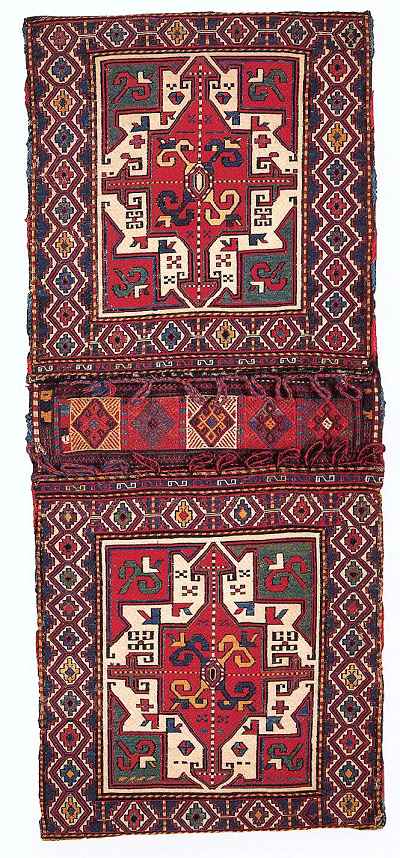Posted by Filiberto Boncompagni on 03-25-2003 09:50 AM:
Another bag
Hi Bertram,
Interesting salon, thank you!
Here is another bag
from "Caucasian Carpets & Covers", page 120.

Like most of the weavings that
- in my humble opinion - appear to be Shahsavan in that book, itís attributed to
Azeri by the authors.
As a matter of fact, Wright and Wertime do not pay
much attention to the Shahsavan: they describe them as "prolific weavers" using
the Moghan Steppe as winter quarters but adding that there is no way to
differentiate their products for similar ones made by other groups.
If you
are right the area of geographic influence of the S. confederacy goes well
beyond the Moghan district.
My habitual suppliers, the Hajjs from Daghestan,
usually sell quite a lot of Shahsavan-looking flat weaves. I suppose some if not
all of those items come from Daghestan itself (Iím going to post a couple of my
recent purchases on Show and Tell).
I understand that the Shahsavan were a
confederation of ethnically mixed tribes that included the Kurds.
That could
explain the variety of motives. A sort of mini-Caucasus inside the
Caucasus.
Could you please show us the design elements you consider as
typically Shahsavan?
Best regards,
Filiberto
Posted by Bertram Frauenknecht on 03-25-2003 11:08 AM:
Hi Filiberto,
this bag looks like it is in nearly too good condition. I'd
love to examine it closely.
I'll send some pics of for me typical Shasavan
designs tomorrow.
When you look into Wertime's or my Shasavan book you will
very qickly notice a number of elements that show up
consistently.
Best
Bertram
Posted by Wendel Swan on 03-25-2003 12:09 PM:
Dear Filiberto and all,
I am familiar with this khorjin. While I donít
have the Wertime/Wright book in front of me, Iím quite certain they attribute
this to the Karabagh area and to the Azeri or Turks there.
One
distinguishing feature of this khorjin is the overlay-underlay brocading used
for the bridge. This technique is used extensively by Turks and Kurds on a
variety of weavings, including covers and bags. It is not characteristic, in my
opinion, of Shahsavan weaving, just as there are some structures used by the
Shahsavan that are used (or very rarely used) by other weavers.
Another
distinguishing feature is that, for some reason, the faces of these Karabagh
khorjin are more elongated than the sumak khorjin of like design that are more
commonly attributed to the Shahsavan. One of the earliest Karabagh examples
published was that face belonging to Joseph V. McMullan and found in From the
Bosporus to Samarkand.
I can also say that the wool in khorjin of this
type from Karabagh, as well as the covers, seems to feel a bit drier than that
used by the Shahsavan.
The cruciform device is found in Turkish weavings,
as Bertram has shown. Its origins can be traced back to much earlier times in
Anatolia. Exactly how and when this and other popular designs came to be used in
Northwest Persia and the Transcaucasus remains largely
unknown.
Incidentally, if Wertime/Wright seem to ignore the Shahsavan in
their book, it is because the concentration was on the production of the
Caucasus, not Persia. The Shahsavan are essentially Persian, although depending
upon what time period we are in, exactly what is Persia and what is the Caucasus
is problematic.
Wendel
Posted by Filiberto Boncompagni on 03-25-2003 12:31 PM:
Thanks Wendel,
Yes, the bag is attributed to Karabagh, mainly because
of the structure of the bridge.
Regards,
Filiberto
Posted by Bertram Frauenknecht on 03-25-2003 04:49 PM:
Karabagh was Shahsavan country in the 18th c. till approx.
1830
Bertram
